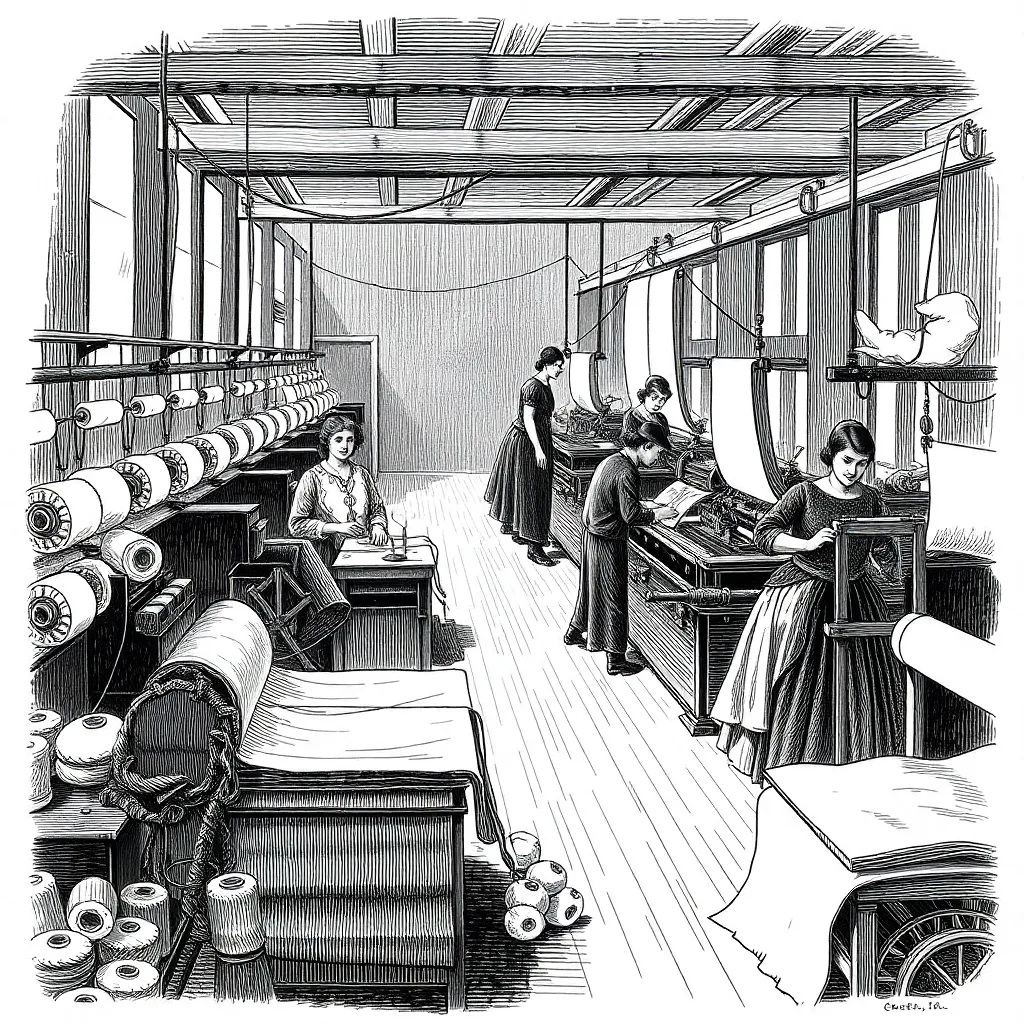The Evolution of Cotton T-Shirts: From Ancient Egypt to Modern Times [Thumbnail: An illustration of an ancient Egyptian wearing a cotton tunic]
The earliest recorded evidence of cotton production dates back to around 3000 BCE in ancient India, where cotton was cultivated and used to create clothing. The use of cotton then spread to ancient Egypt, where it was highly valued for its softness, durability, and breathability. In fact, according to the British Museum, Egyptian tombs have yielded fragments of cotton fabrics dating back to around 2500 BCE.
The ancient Egyptians used cotton to create a variety of clothing items, including tunics and loincloths. These early garments were often decorated with intricate designs and patterns, showcasing the Egyptians’ advanced textile skills. The use of cotton continued to spread throughout the ancient world, with the Greeks and Romans also adopting it as a popular fabric for clothing.
Fast-forward to the Middle Ages, where cotton production and trade flourished in Europe. The fabric became a staple in many European countries, particularly in Italy and Spain, where it was used to create luxurious clothing for the wealthy. The Industrial Revolution in the 18th and 19th centuries further accelerated cotton production, making it more accessible and affordable for the masses.
In the late 19th and early 20th centuries, the modern version of the cotton t-shirt as we know it today began to take shape. The first commercially available cotton t-shirts were produced in the United States in the 1920s, with brands like Fruit of the Loom and Hanes becoming household names. Since then, the cotton t-shirt has become a wardrobe staple, with countless styles, designs, and brands emerging over the years.
Ancient Egypt: The Birthplace of Cotton
The cultivation of cotton in ancient Egypt dates back to around 2500 BCE, marking the beginning of a long history of cotton production. This early adoption of cotton allowed the Egyptians to create clothing that was well-suited to their hot and dry desert climate.
The Egyptians used cotton to craft lightweight and breathable garments, including tunics and loincloths. These early cotton garments were likely worn by people from all walks of life, from the wealthy elite to the working class, providing them with comfort and protection from the harsh desert environment.
The use of cotton in ancient Egyptian clothing also highlights the resourcefulness and innovation of the Egyptians. By utilizing a crop that was well-suited to their climate, they were able to create clothing that was both functional and comfortable. This early example of cotton production and use laid the foundation for the widespread adoption of cotton in later civilizations.

Middle Ages: The Spread of Cotton
The expansion of trade routes played a significant role in the dissemination of cotton production and weaving techniques throughout the Mediterranean region. As merchants and travelers moved goods and ideas across the continent, they brought with them knowledge of cotton cultivation and textile production, which eventually took root in various parts of the region.
During the Middle Ages, cotton fabrics became highly sought after for their exceptional softness, durability, and ease of care. The unique properties of cotton made it an ideal material for clothing, and its popularity soared among both the nobility and commoners. According to historical records, cotton clothing was worn by people from all walks of life, from royal courts to rural villages.
However, the quality and intricacy of cotton garments varied greatly depending on social status. The wealthy and powerful could afford luxurious fabrics with intricate designs and patterns, often imported from distant lands. In contrast, commoners wore simpler, more practical clothing made from locally produced cotton. Despite these differences, cotton remained a staple material in the wardrobes of people across the Mediterranean region.
Industrial Revolution: Mass Production and the Rise of the T-Shirt
The Industrial Revolution played a pivotal role in transforming the cotton industry, and subsequently, the history of cotton t-shirts. With the advent of new textile machinery, mass production of cotton fabrics became possible, leading to a significant reduction in costs and making them more affordable for the general population.
This newfound accessibility had a profound impact on the way people dressed, as cotton fabrics became a staple in many households. The increased availability of cotton fabrics also paved the way for the development of new clothing items, including the modern t-shirt.
The first modern t-shirts, made from cotton jersey fabric, emerged in the late 19th century as undershirts for men. This marked a significant shift away from the traditional labor-intensive methods of producing clothing, and towards a more industrialized and efficient process.
According to the Smithsonian National Museum of American History, the industrial production of cotton fabrics during the Industrial Revolution led to a “democratization of fashion,” making fashionable clothing accessible to people of all social classes. This democratization of fashion laid the groundwork for the widespread adoption of the t-shirt as a casual, everyday garment.

20th Century: The T-Shirt Becomes a Fashion Icon
The transformation of the t-shirt from an undergarment to a fashion staple was a significant development in the 20th century. Initially, t-shirts were plain, white, and reserved for layering under clothing. However, with the advent of screen printing and dyeing techniques, the humble t-shirt was elevated to a new level of creativity and expression.
The ability to produce bold graphics and vibrant colors on t-shirts enabled individuals to showcase their personality, interests, and affiliations. This newfound freedom of expression turned the t-shirt into a canvas, allowing people to convey messages, showcase humor, or simply make a fashion statement. As a result, the t-shirt became an integral part of modern fashion, transcending its utilitarian origins.
The rise of casual wear and streetwear in the latter half of the 20th century further solidified the t-shirt’s position in the fashion world. With the increasing popularity of relaxed, comfortable clothing, the t-shirt became a staple in many people’s wardrobes. Streetwear, in particular, played a significant role in elevating the t-shirt’s status, as it often featured bold graphics, logos, and catchy slogans.

Modern Times: Sustainability and Innovation
The shift towards sustainability in the cotton t-shirt industry is a significant step forward, as the traditional production methods have been criticized for their environmental impact. According to the United States Environmental Protection Agency, the textile industry is one of the largest contributors to waste and pollution. By adopting eco-friendly production methods, brands can reduce their carbon footprint and minimize waste.
The use of organic cotton is another important aspect of sustainable production. Organic cotton farming eliminates the use of toxic pesticides and synthetic fertilizers, promoting healthier soil and reducing the risk of water pollution. This not only benefits the environment but also improves the livelihoods of cotton farmers. As consumers become more aware of the environmental and social implications of their purchasing decisions, the demand for organic cotton products is likely to increase.
The incorporation of recycled materials into cotton t-shirt designs is also gaining popularity. This approach reduces the amount of waste sent to landfills and conserves natural resources. Recycled cotton can be sourced from post-consumer waste, such as old clothing, or from manufacturing waste, like fabric scraps. By using recycled materials, brands can create high-quality products while minimizing their environmental impact.
The athleisure wear trend has driven innovation in cotton fabrics, with brands developing high-performance materials that combine comfort, durability, and style. These advanced fabrics often feature moisture-wicking properties, four-way stretch, and quick drying capabilities, making them ideal for active lifestyles. As consumers increasingly prioritize comfort and practicality, the demand for high-performance cotton fabrics is likely to continue growing.
Conclusion: A Timeless Classic
The origins of the cotton t-shirt can be traced back to ancient Egypt, where cotton was first cultivated around 2500 BCE. The Egyptians used cotton to create lightweight, breathable clothing that was perfect for their hot desert climate. Fast forward to the 19th century, when cotton became a staple crop in the southern United States, leading to the mass production of cotton fabrics.
The modern t-shirt as we know it today originated in the late 19th century, with the introduction of the “union suit,” a one-piece undergarment made of cotton or wool. During World War I, the US military issued cotton t-shirts as undershirts to soldiers, and they quickly became popular among civilians as well. By the mid-20th century, the t-shirt had become a casual fashion staple, with the introduction of printed designs and logos.
Today, cotton t-shirts are a ubiquitous part of our daily lives, with billions produced every year. The rise of fast fashion has made t-shirts more affordable and accessible than ever, with many retailers offering custom designs and prints. According to the Cotton Incorporated website, the average American owns around 15 t-shirts, and the global t-shirt market is projected to reach $10.3 billion by 2025.
Despite concerns over the environmental and social impact of fast fashion, the cotton t-shirt remains an enduring symbol of comfort, practicality, and self-expression. As fashion trends continue to evolve, it’s likely that the humble t-shirt will remain a timeless classic, adapting to new styles and technologies while remaining true to its roots as a simple, versatile, and comfortable garment.
